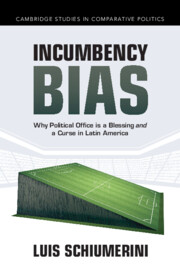Refine search
Actions for selected content:
171 results
Measuring How Much Judges Matter for Case Outcomes
-
- Journal:
- Journal of Law and Courts ,
- Published online by Cambridge University Press:
- 20 August 2025, pp. 1-22
-
- Article
-
- You have access
- Open access
- HTML
- Export citation
Chapter 1 - Introduction
-
- Book:
- Direction Dependence Analysis
- Published online:
- 16 September 2025
- Print publication:
- 14 August 2025, pp 1-27
-
- Chapter
- Export citation
Estimating the Local Average Treatment Effect Without the Exclusion Restriction
-
- Journal:
- Political Analysis , First View
- Published online by Cambridge University Press:
- 21 July 2025, pp. 1-15
-
- Article
- Export citation
Studying Philosophy Does Make People Better Thinkers
-
- Journal:
- Journal of the American Philosophical Association , First View
- Published online by Cambridge University Press:
- 11 July 2025, pp. 1-19
-
- Article
-
- You have access
- Open access
- HTML
- Export citation
8 - Correlation
-
- Book:
- Probability and Statistics for Data Science
- Published online:
- 19 June 2025
- Print publication:
- 03 July 2025, pp 284-324
-
- Chapter
- Export citation
4 - Multiple Discrete Variables
-
- Book:
- Probability and Statistics for Data Science
- Published online:
- 19 June 2025
- Print publication:
- 03 July 2025, pp 109-160
-
- Chapter
- Export citation
7 - Averaging
-
- Book:
- Probability and Statistics for Data Science
- Published online:
- 19 June 2025
- Print publication:
- 03 July 2025, pp 241-283
-
- Chapter
- Export citation
7 - Spatial Regression and Multiscale Analysis
-
- Book:
- Spatial Analysis
- Published online:
- 19 June 2025
- Print publication:
- 03 July 2025, pp 189-226
-
- Chapter
- Export citation
What to Observe When Assuming Selection on Observables
-
- Journal:
- Political Analysis , First View
- Published online by Cambridge University Press:
- 27 June 2025, pp. 1-22
-
- Article
-
- You have access
- Open access
- HTML
- Export citation
Generalizing Trimming Bounds for Endogenously Missing Outcome Data Using Random Forests
-
- Journal:
- Political Analysis , First View
- Published online by Cambridge University Press:
- 26 June 2025, pp. 1-15
-
- Article
-
- You have access
- Open access
- HTML
- Export citation

Incumbency Bias
- Why Political Office is a Blessing and a Curse in Latin America
-
- Published online:
- 17 May 2025
- Print publication:
- 05 June 2025
Minority Legislators Sponsor and Cosponsor Differently from White Legislators: Causal Evidence from U.S. Congress
-
- Journal:
- Journal of Race, Ethnicity and Politics / Volume 10 / Issue 2 / July 2025
- Published online by Cambridge University Press:
- 28 April 2025, pp. 277-289
-
- Article
-
- You have access
- Open access
- HTML
- Export citation
Leveraging causality and explainability in digital agriculture
-
- Journal:
- Environmental Data Science / Volume 4 / 2025
- Published online by Cambridge University Press:
- 17 April 2025, e23
-
- Article
-
- You have access
- Open access
- HTML
- Export citation
Transcending the brain disease versus disorder dichotomy: a critical realist perspective on psychiatric disorders
-
- Journal:
- BJPsych Bulletin / Volume 49 / Issue 5 / October 2025
- Published online by Cambridge University Press:
- 15 April 2025, pp. 325-328
- Print publication:
- October 2025
-
- Article
-
- You have access
- Open access
- HTML
- Export citation
Mental health homicide inquiries in England 2010–2023: review of methodology and findings – commentary, Crichton
-
- Journal:
- The British Journal of Psychiatry / Volume 227 / Issue 4 / October 2025
- Published online by Cambridge University Press:
- 03 April 2025, pp. 734-735
- Print publication:
- October 2025
-
- Article
- Export citation
Investigating the relationship between attention-deficit hyperactivity disorder (ADHD) and C-reactive protein (CRP): observational, polygenic risk score, and Mendelian randomization analyses
-
- Journal:
- Psychological Medicine / Volume 55 / 2025
- Published online by Cambridge University Press:
- 31 March 2025, e103
-
- Article
-
- You have access
- Open access
- HTML
- Export citation
Seeing Like a District: Understanding What Close-Election Designs for Leader Characteristics Can and Cannot Tell Us
-
- Journal:
- Political Analysis / Volume 33 / Issue 4 / October 2025
- Published online by Cambridge University Press:
- 27 March 2025, pp. 393-411
-
- Article
-
- You have access
- Open access
- HTML
- Export citation
Understanding the impact of the 2018 voter ID pilots on turnout at the London local elections: A synthetic difference-in-difference approach
-
- Journal:
- Political Science Research and Methods , First View
- Published online by Cambridge University Press:
- 19 March 2025, pp. 1-18
-
- Article
-
- You have access
- Open access
- HTML
- Export citation
CausalMetaR: An R package for performing causally interpretable meta-analyses
-
- Journal:
- Research Synthesis Methods / Volume 16 / Issue 2 / March 2025
- Published online by Cambridge University Press:
- 12 March 2025, pp. 425-440
-
- Article
-
- You have access
- Open access
- HTML
- Export citation
Some problems of causal inference in agent-based macroeconomics
-
- Journal:
- Economics & Philosophy / Volume 41 / Issue 3 / November 2025
- Published online by Cambridge University Press:
- 10 March 2025, pp. 534-556
-
- Article
-
- You have access
- Open access
- HTML
- Export citation

